The recent selloff that rocked equity markets worldwide is leaving investors in a state of uncertainty. The S&P 500 and Nasdaq Composite have both experienced significant drops, with the Nasdaq recording its first 10% correction since 2022. The sharp decline in both Europe and Asia, especially Japan’s Nikkei index, has raised concerns among market participants. The question now is whether this is a buying opportunity or a sign of more losses to come.
Investors face a dilemma as another week of trading looms ahead. While buying stocks during periods of weakness has proven fruitful in the past, the current economic conditions are less than favorable. Last week’s alarming U.S. data has raised fears of a looming recession. Historically, the S&P 500 has fallen an average of 29% during recessions, a statistic that is hard to ignore. Moreover, Warren Buffet’s Berkshire Hathaway’s recent actions, including selling half of its stake in Apple and accumulating a massive cash pile, are adding to the unease in the market.
Elevated Valuations and Recession Fears
Elevated valuations and fears of an impending recession are causing investors to reassess their risk positions. The market’s rally this year, driven by artificial intelligence technology and a resilient economy, is now facing headwinds. The Federal Reserve’s reluctance to cut interest rates and disappointing tech earnings have made investors wary. Concerns have been raised that stocks may be overvalued, leading to the recent market selloff.
Amidst the gloom and uncertainty, some investors see a silver lining. The recent market tumble may present an opportunity to buy into expensive names that were previously out of reach. Bright spots, such as the second straight month of hefty job growth and strong earnings from tech giants like Apple and Facebook-parent Meta Platforms, offer hope for a rebound. While stock valuations remain elevated, there are still pockets of strength in the market.
The Fear of Normalization
The fear of the economy normalizing after a period of robust growth is weighing on investor sentiment. While stock valuations have edged lower, they still remain high compared to historical standards. The recent market reaction to signs of economic normalization underscores the fragility of the current market environment. Investors may be quick to take profits and seek shelter in safe havens amidst growing uncertainty.
The Cboe Volatility Index, Wall Street’s fear gauge, spiked to its highest level since March 2023 as traders sought protection against a market selloff. The sharp decline in the yield on the 10-year U.S. Treasury bond reflects growing concerns over economic growth. With major economic data releases still a few weeks away, markets remain on edge. The lack of clarity and the backdrop of economic uncertainty are keeping investors cautious.
The recent selloff in equity markets has raised significant doubts among investors. While some see it as a buying opportunity, others view it as a warning sign. The heightened market volatility, fears of recession, and concerns over high stock valuations are creating a challenging environment for investors. Navigating this uncertainty will require a careful assessment of risks and a strategic approach to investing in a rapidly changing market landscape.

